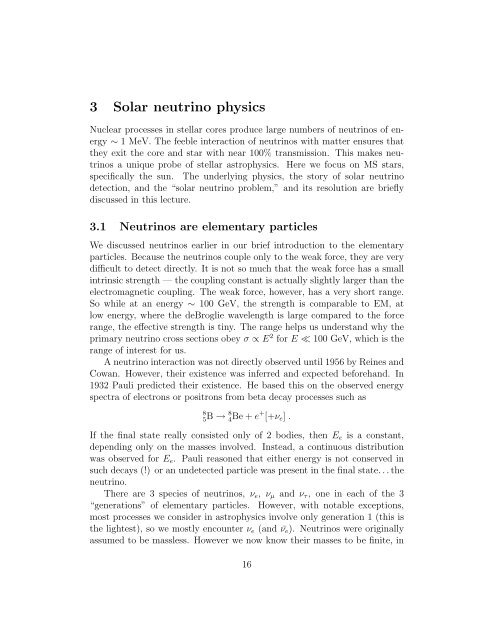Lecture Notes for Astronomy 321, W 2004 1 Stellar Energy ...
Lecture Notes for Astronomy 321, W 2004 1 Stellar Energy ...
Lecture Notes for Astronomy 321, W 2004 1 Stellar Energy ...
Create successful ePaper yourself
Turn your PDF publications into a flip-book with our unique Google optimized e-Paper software.
3 Solar neutrino physics<br />
Nuclear processes in stellar cores produce large numbers of neutrinos of energy<br />
∼ 1 MeV. The feeble interaction of neutrinos with matter ensures that<br />
they exit the core and star with near 100% transmission. This makes neutrinos<br />
a unique probe of stellar astrophysics. Here we focus on MS stars,<br />
specifically the sun. The underlying physics, the story of solar neutrino<br />
detection, and the “solar neutrino problem,” and its resolution are briefly<br />
discussed in this lecture.<br />
3.1 Neutrinos are elementary particles<br />
We discussed neutrinos earlier in our brief introduction to the elementary<br />
particles. Because the neutrinos couple only to the weak <strong>for</strong>ce, they are very<br />
difficult to detect directly. It is not so much that the weak <strong>for</strong>ce has a small<br />
intrinsic strength — the coupling constant is actually slightly larger than the<br />
electromagnetic coupling. The weak <strong>for</strong>ce, however, has a very short range.<br />
So while at an energy ∼ 100 GeV, the strength is comparable to EM, at<br />
low energy, where the deBroglie wavelength is large compared to the <strong>for</strong>ce<br />
range, the effective strength is tiny. The range helps us understand why the<br />
primary neutrino cross sections obey σ ∝ E 2 <strong>for</strong> E ≪ 100 GeV, which is the<br />
range of interest <strong>for</strong> us.<br />
A neutrino interaction was not directly observed until 1956 by Reines and<br />
Cowan. However, their existence was inferred and expected be<strong>for</strong>ehand. In<br />
1932 Pauli predicted their existence. He based this on the observed energy<br />
spectra of electrons or positrons from beta decay processes such as<br />
8<br />
5B → 8 4Be + e + [+ν e ] .<br />
If the final state really consisted only of 2 bodies, then E e is a constant,<br />
depending only on the masses involved. Instead, a continuous distribution<br />
was observed <strong>for</strong> E e . Pauli reasoned that either energy is not conserved in<br />
such decays (!) or an undetected particle was present in the final state. . . the<br />
neutrino.<br />
There are 3 species of neutrinos, ν e , ν µ and ν τ , one in each of the 3<br />
“generations” of elementary particles. However, with notable exceptions,<br />
most processes we consider in astrophysics involve only generation 1 (this is<br />
the lightest), so we mostly encounter ν e (and ¯ν e ). Neutrinos were originally<br />
assumed to be massless. However we now know their masses to be finite, in<br />
16













